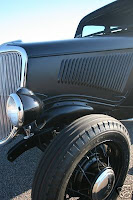



You can also see how I welded the quater panels into the B pillar to create the solid new rear quarters. The doors were now put on the hinges and closed for the first time. Talk about a "barn door" kind of fit! AGHHH! I had done another '34 back in the early 1990's and really could never overcome this problem on the car. I had to cheat at the end and actually cut the sub rails in front of the B pillar and create a step down towards the front of the car. This lifted the door up, but it still was never right. See photo below:
 My mistake was to weld the B pillar to the subrail too early, and therefore "paint myself in a corner" with nowhere to go.
My mistake was to weld the B pillar to the subrail too early, and therefore "paint myself in a corner" with nowhere to go.Now with the door in, and the cowl bolted down, it was just a matter of pushing the tail of the car down, and lifting the bottom of the door up. With a little pushing and pulling I was able to get a perfect fit. Once the fit was established, I tack welded the rear inner fender panels to the subrails, welded backets to the B pillars and welded them to the sub rails, and waalaa! Perfect alignment - sort of... After several trys I realized that you have to overshoot the target some, as the body weight is applied, the door wants to sag. But that is the thing about building cars out of junk. You have to be willing to do and re-do and re-do again until its right. Sometimes it will stress the patience and ego, but in the end you have a really nice car.























 But where do you start? What needs to be done first? As with any project its really just a series of small projects done one after another. If you look at it in that way, it keeps you focused and help prevent the feeling of being overwhelmed with the project. First thing I did was to take inventory of what I had, and what I needed. The frame was garbage, as where the doors and decklid. The tops of the quarter panels was usable, and the roof could be salvaged.
But where do you start? What needs to be done first? As with any project its really just a series of small projects done one after another. If you look at it in that way, it keeps you focused and help prevent the feeling of being overwhelmed with the project. First thing I did was to take inventory of what I had, and what I needed. The frame was garbage, as where the doors and decklid. The tops of the quarter panels was usable, and the roof could be salvaged.







